
Trametes versicolor – also known as Coriolus versicolor and Polyporus versicolor – is a common polypore mushroom found throughout the world. Meaning 'of several colors', versicolor reliably describes this fungus that displays different colors. For example, because its shape and multiple colors are similar to those of a wild turkey, T. versicolor is commonly called turkey tail. A similar looking mushroom, commonly called false turkey tail, which is from a different order, may sometimes be confused with the turkey tail mushroom due to appearance. Another lookalike is the multicolor gill polypore.
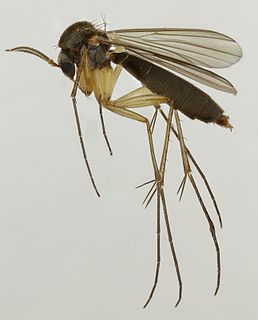
The Mycetophilidae are a family of small flies, forming the bulk of those species known as fungus gnats. About 3000 described species are placed in 150 genera, but the true number of species is undoubtedly much higher. They are generally found in the damp habitats favoured by their host fungi and sometimes form dense swarms.

Bolitophila cinerea is a Palearctic species of 'fungus gnat' in the family Bolitophilidae.

Cordyla flaviceps is a Palearctic species of 'fungus gnat' in the family Mycetophilidae.The type-locality is Copenhagen (Denmark). C. flavicepsis a mycetophage associated with Russula and Lactarius.

Diadocidia ferruginosa is a Palearctic species of fungus gnat in the family Mycetophilidae. They live as larvae in long dry silken tubes under bark or in rotten wood and probably feed on fungal mycelia or spores. Also associated with Peniophora.
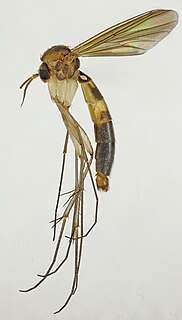
Exechia contaminata is a Palearctic species of fungus gnat in the family Mycetophilidae. Exechia contaminata is chiefly or exclusively associated with Russula and Lactarius.

Exechia spinuligera is a Palearctic species of fungus gnat in the family Mycetophilidae. Exechia contaminata is chiefly or exclusively associated with Russula and Lactarius.

Isoneuromyia semirufa is a Palearctic species of 'fungus gnat' in the family Mycetophilidae. The members of this genus [Orfelia] are, as larvae, web spinners chiefly associated with dead wood where they feed on fungal hyphae. They also could be found in turf, grass tussocks, under logs and boulders, in worm tunnels, among mosses and liverworts. They were discovered in 2006 in China: Zhejiang province: Wuyanling National Natural Reserve, Yiping Wang along with 3 Isoneuromyia Isoneuromyia baumhaueri, Isoneuromyia signata and orfelia semirufa
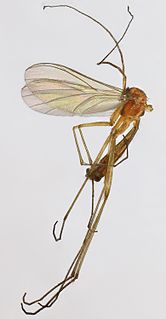
Macrocera parva is a Palearctic species of 'fungus gnat' in the family Keroplatidae.Larvae of species in this genus have been reared from a range of situations including clumps of turf, rotting wood and cave walls and are thought to be predaceous.

Mycetophila edwardsi is a Palearctic species of 'fungus gnat' in the family Mycetophilidae. Mycetophila edwardsi is found in forest or wooded areas where the larvae develop in fruiting bodies of large fungi.

Mycetophila fungorum is a Palearctic species of 'fungus gnats' in the family Mycetophilidae. Mycetophila fungorum is found in forest or wooded areas where the larvae develop in Agaricales and also obtained with emergence traps over dead wood, soil and ground flora.
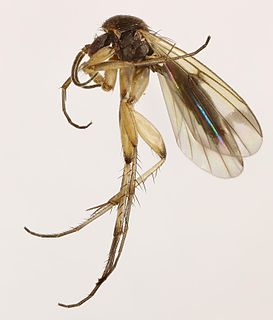
Mycetophila luctuosa is a Palearctic species of 'fungus gnats' in the family Mycetophilidae. Mycetophila luctuosa is found in forest or wooded areas where the larvae develop in Neolentinus lepideus, Kretzschmaria deusta, Chondrostereum purpureum, Sebacina incrustans, Neolentinus tigrinus, Pleurotus spp., Trametes versicolor and a wide range of epigeic fungi, mostly Russulaceae.
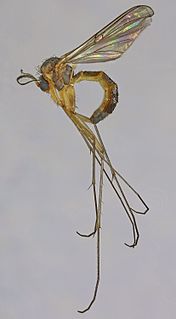
Mycomya cinerascens is a Palearctic species of 'fungus gnats' in the family Mycetophilidae. Mycomya cinerascens is found in forest or wooded areas where the larvae develop in fruiting bodies of Stereum, Thelephora terrestris and Cortinarius sp..Besides fruiting bodies the species has been collected with emergence traps over beech logs and stumps, alder and spruce stumps.

Brachypeza bisignata is a Palearctic species of 'fungus gnat' in the family Mycetophilidae. Reared from puffballs (Lycoperdales).

Boletina trivittata is a Palearctic species of 'fungus gnat' in the family Mycetophilidae. Members of this genus are found in a wider variety of habitats from wooded streams to wetlands and open moorland. Adults have been obtained in emergence traps in a range of situations including rotting wood and soil litter.
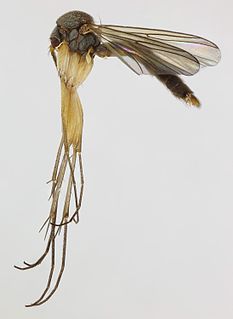
Brevicornu foliatum is a Palearctic species of 'fungus gnat' in the family Mycetophilidae. Members of this genus are found in a wider variety of habitats from wooded streams to wetlands and open moorland. Larvae develop in dead wood and in soil litter, feeding probably on microfungi.

Mycetophila is a genus of fungus gnats in the family Mycetophilidae. There are at least 740 described species in Mycetophila.
Mycetophila sigmoides is a species of fungus gnats in the family Mycetophilidae.

Mycetophila unipunctata is a species of fungus gnats in the family Mycetophilidae.
Mycetophila elegans is a species of 'fungus gnats' in the family Mycetophilidae.

















